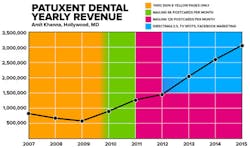How one doctor grew his new patient count by 500% and his revenue by 355% in 5 years
Joy Gendusa
AMIT KHANNA, DMD, a young dentist and father of two, purchased his first dental practice in 2006 with big plans for the future.
Patuxent (pronounced Puh-TUCK-sent) Dental is situated in Hollywood, Maryland, a fairly rural area about 50 miles outside of Washington, DC. The population there is roughly 10,400, so you have an idea of what we're working with here.
I think it's fair to say things started out less than ideal for Dr. Khanna. From his first year in business to his third, revenue declined 14%.
Not a great start.
But this year, he's on track to make over $3 million, a revenue growth of more than 350% in the last five years. The practice that started out with one doctor and a staff of five now boasts three doctors and 15 staff members.
I wanted to know: what happened between then and now?
I sat down recently with Dr. Khanna to discuss how he turned things around. In the interest of full disclosure, he is a customer of mine. I know Dr. Khanna as a detail-oriented business owner, a meticulous marketer, and a successful dentist. So it was a surprise to me to learn this wasn't always the case.
Here's how he took his revenue from ho-hum to highest-ever:
Phase 1: When revenue declines 14%, you have to change something.
Unlike most suburban dental practices with a prospective new patient radius of about three to five miles, Patuxent Dental draws from a radius of about 20 driving miles. The practice has plenty of competition, though. Within that 20-mile radius there are 20 dental practices!
Patuxent Dental is very high-tech, yet relaxed and nonintimidating. They opt to play rock and roll music over the waiting room speakers instead of turning on daytime TV (something I appreciate).
Dr. Khanna opened the practice, like many dentists, without any formal business training or marketing know-how. The focus, of course, was on patient experience. "My marketing consisted of a homemade yard sign, yellow pages, and things of that nature," he says.
For the first few years, growth declined. Something needed to change - like the marketing. Dr. Khanna educated himself and poured over all the options-digital, print, broadcast, etc. What stood out to him, though, was simple. Postcards.
Dr. Khanna: "I had been receiving marketing pieces from PostcardMania on a regular basis. They always caught my eye and I thought to myself that if they caught my eye, why wouldn't they catch the eye of my customers as well?"
He followed his intuition, sending out his first postcard campaign: a modest 6,000 postcards. The results?
Dr. Khanna: "What we discovered was that people didn't know we were there or what we offered. We were there-we're on the main street, big sign-and people who lived across the street would come in after receiving the postcards and say, 'We didn't know you were here!'"
No matter how patient-ready your practice is, you can't grow if people don't know you're there!
Phase 2: Getting your name out can have an immediate impact-like a 92% increase in revenue.
Throughout 2010, Dr. Khanna sent out 6,000 postcards every month to people in his county and surrounding zip codes with an income of more than $20,000. That year his revenues rose 24%, after a 6% decrease the year before. He didn't need much convincing after that to keep mailing!
Dr. Khanna: "We started off doing small batches of postcards very consistently. As we saw we were getting a really good return on investment, we started increasing the number of cards we sent out."
Let's look at some numbers:
• Average new patients before postcards: 30/month
• Average new patients after postcards: 50/month
That's after monthly mailings of just 6,000 postcards! With every new patient worth an estimated $1,000 in immediate revenue (Dr. Khanna's estimation, not mine), that's an extra $20,000 per month on average!
In 2011, Dr. Khanna doubled his mailings to 12,000 postcards per month-still the only marketing he was doing. His revenues went up 55% over the year before. As his practice grew, so did his marketing budget. (As it should!)
Phase 3: Integrate your marketing efforts for bigger returns-like a 1,300% ROI.
Dr. Khanna added more marketing to the mix. Not all of it worked. Advertising his practice on grocery store receipts and in local phone books were "complete failures," he said. Building on the success of his direct mail campaign, in 2013 Dr. Khanna got on board with an integrated postcard campaign called DirectMail2.0: New Patient Edition. His revenues shot up nearly $500,000 over 2011. He was seeing almost 100 new patients per month. (Remember, he started at about 30/month!)
This campaign integrates postcards with geographically targeted online ads. This creates the feeling that a practice is "everywhere" in an industry where repetition is vital.
Then, the doctor created a Facebook page for the practice. By sponsoring posts and encouraging patients to like his page, Dr. Khanna now dominates the region's dental practices with more than 3,700 likes. (His closest competitors have fewer than 200!)
Dr. Khanna: "When people move to this area they'll post, 'Hey, what dentist should I go to?' and 25 people will post, 'You've got to go see Dr. Khanna.'" (If that's not a testament to great patient experience, I don't know what is!)
Next, the doctor recorded a commercial and invested in local television spots. In a larger community, the return might not justify the cost, but in a more rural region, it's very affordable. The practice continued to grow: In 2013, revenues went up another 48%.
Phase 4: If something's working, do more of it. And track, track, track. Rigorous tracking is key to understanding what kind of return you're getting for your efforts. The doctor puts it this way:
Dr. Khanna: "We're getting about 170 to 190 new patients a month, so roughly 2,000 a year. The return on investment is huge. We're probably generating about $2 million a year from [new patients]."
Let's look at the big picture.
• Yearly marketing budget: $104,760
• New patients generated per year: 2,000
• Yearly value of a new patient: $1,000
• Yearly revenue: $2 million
• ROI: 1,809%
And here's what Dr. Khanna spends on each medium annually:
• Postcards: $70,000
• Local news website: $9,600
• Movie theater ads: $9,360
• Television: $7,400
• Facebook: $6,000
• Yelp: $2,400
Dr. Khanna says postcards are the driving force behind his marketing, and integrating other types of marketing has only compounded his results.
Dr. Khanna: "There's no magic bullet when it comes to marketing. We do a combination of postcards, Facebook, and television ads, asking our patients directly for referrals. I think the key is to have it all talk to one another-color schemes, designs; it all just has to flow into one cohesive marketing whole."
See Dr. Khanna's complete marketing story in video format at postcardmania.com/dr-khanna. And as a Dental Economics reader, you are entitled to 5,000 free dental postcards, printed by PostcardMania, as well as free samples of postcards that are working right now for other dental practices. Redeem online or call (844) 269-1836 today—free marketing advice for your practice is also included!
JOY GENDUSA is the founder and CEO of PostcardMania. Using just postcards, a phone, and a computer, Joy built PostcardMania from a one-person start up into an industry leader serving over 68,000 clients, plus more than 4,500 dentists. Need help promoting your practice? Email her at [email protected] or visit postcardmania.com/dentaldesigns.


